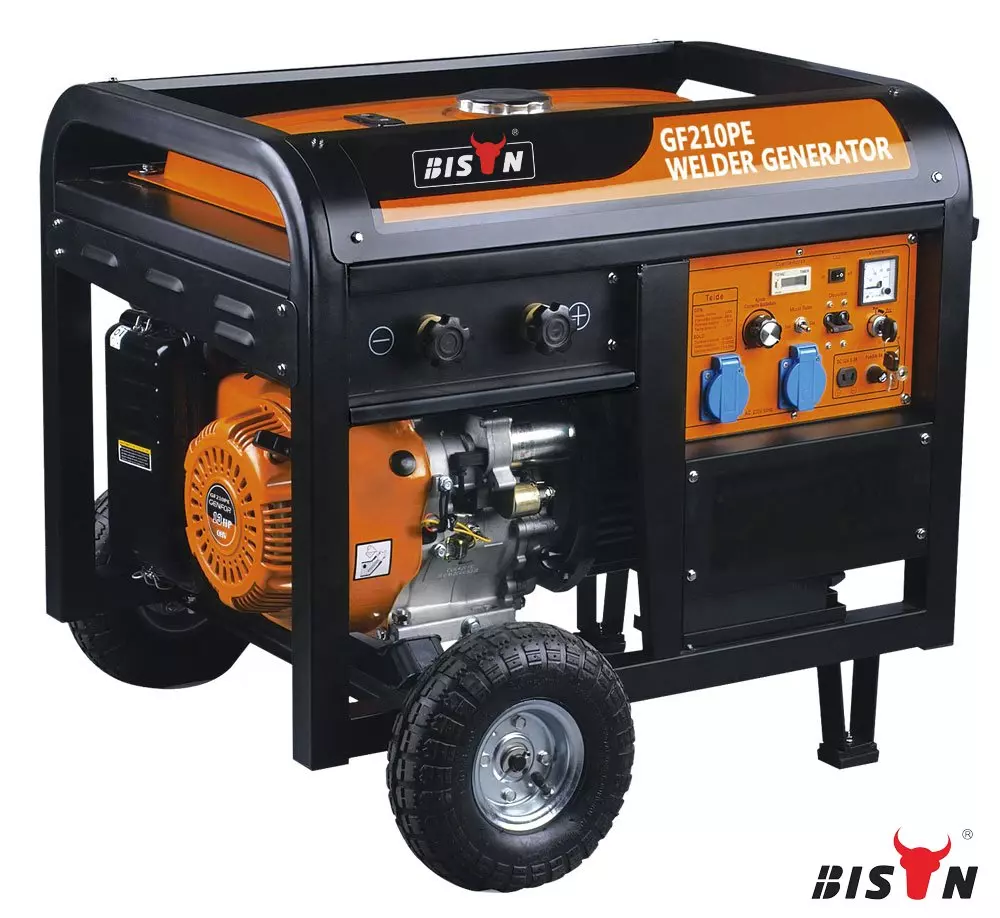welding generator vs. normal generator: unraveling the differences
2024-01-24
Table of content
Among industries that rely heavily on generators, the welding industry has a unique perspective. Welders are the architects of steel, and they need more than just a normal generator, they need a welding generator that can provide a steady, reliable source of electrical current. Any fluctuation, even the slightest disturbance, can disrupt the arc and cause damage to the weld – unacceptable in an industry where strength and precision are critical.
So now the question arises – are normal generators adequate for this critical task? This article aims to address these curious questions. As you read this article, you will understand the basic aspects of normal generators and welding generators - their introduction, pros and cons, applications, and most importantly, their differences and similarities.
welding generators
A welder generator generates electricity for welding without relying on mains electricity. The welder generator can power your welding equipment wherever needed by filling the fuel tank, just like a normal generator. At its heart is an engine (fueled by diesel, gasoline, or propane) that drives an alternator to generate electricity.
However, unlike conventional generators, welding generators are specifically designed to facilitate welding processes, including metal inert gas (MIG), tungsten inert gas (TIG) and manual welding (shielded metal arc welding or SMAW) welding techniques.
The welding function focuses on producing high output current at the available welding voltage (typically in the 20-100 volt range), thus being able to melt metal and form strong and durable joints.
When a dual-function system switches to standard power supply mode, the target shifts from high current and low voltage to lower current and higher voltage, suitable for running appliances and tools.

Advantages and disadvantages of welding generators
advantage:
-
Versatility: When the welding generator is unused, this generator can power things like lights, tools, etc. You can directly plug in the tools you need and use them usually.
-
Mobility: Reinforcement design for welding environment, it can withstand rough handling.
-
Durability: Welding generators can withstand high levels of wear, especially associated with heavy-duty welding processes, and are often deployed in harsh environments.
Disadvantages:
-
Cost: Due to their dual functionality, these generators can be more expensive compared to normal generators.
-
Fuel consumption: Welding generators typically consume more fuel due to their high voltage and power output requirements. Therefore, their operating costs may be higher.
-
Maintenance: Since they are more complex machines than ordinary machines, maintenance requirements are higher.
Welding generator applications
Due to its wide range of functions, welding generators have a wide range of applications. They are widely used in the construction and mining industries where infrastructure development requires on-site manufacturing and assembly. Welding generators can be found on the back of vehicles, construction sites, shipyards, and even in secluded oil pipelines.
Besides, in disaster-stricken areas, where power outages are often one of the direct consequences, these machines serve as beacons of hope, providing power while aiding in the repair and rebuilding process through welding operations.
normal generator
Normal generators are a lifeline during power outages, providing essential power to various domestic, industrial and recreational sectors. There are many types to suit different needs: portable generators, backup generators, and inverter generators.
Portable generators are compact, mobile units that are ideal for short-term power needs, such as camping or responding to sudden power outages.
A backup generator, on the other hand, is a larger unit that is primarily used as emergency backup power for residential or commercial purposes. They automatically start up when a power outage is detected, which is very convenient when it comes to maintaining uninterrupted power.
Inverter generators represent advanced technology; they generate alternating current, convert it to direct current, and then invert it back to cleaner alternating current that is more stable and suitable for sensitive electronic equipment.
normal generator applications
From providing indispensable backup power for homes and hospitals to decentralized power at concerts and construction sites, normal generators have become ubiquitous. Additionally, you'll find them on construction sites providing power to a variety of construction equipment.
Differences and similarities between a welding generator and a normal generator
The conversation becomes even more intricate when the focus shifts to a comparative analysis of welding generators versus conventional generators. Generators and welding generators perform different essential functions but share some similarities. The key similarities and differences between a normal generator and a welder generator are:
Similarities
Power generation
Both of these are capable of operating as a backup power source. They can provide a power source for various applications, including powering tools, equipment, and appliances.
Fuel sources
Certain kinds of generators can run on gasoline, diesel, or propane, depending on the model and requirements of the application.
Control panel
Both generators usually have a control panel that allows users to monitor and adjust parameters such as voltage and current. The board may also include outlets for connecting electrical equipment.
Differences
Basic function
The core functional difference between welding generators and normal generators is their primary output. The primary purpose of a normal generator is to generate electricity for general use. A welding generator, on the other hand, is designed to serve dual functions: welding and power generation. It integrates the welding machine with the generator in one unit. The ability of a welding generator to switch between the function of providing regular power and supplying welding current is a significant difference.
Power output
As for power output, conventional generators typically range from 2,000 to 10,000 watts. In comparison, welding generators exhibit higher power output, nominally between 3,000 and 15,000 watts, which is necessary to maintain a stable welding arc.
Output type
Something to note in the comparison is the output type – AC (alternating current) and DC (direct current). Conventional generators primarily provide AC power suitable for most household and commercial appliances. However, for welding operations, DC is often ideal because it provides a stable arc and better penetration.
Output stability
Output stability, expressed as total harmonic distortion (THD), is a key parameter in this comparison. THD is a measure of the cleanliness of the power supply output. The lower the THD value, the cleaner and more stable the power supply is. Welding generators typically have THD levels below 5%, making them ideal for welding activities as they provide a more stable and cleaner power source. Most conventional generators (unless they are inverter types) are likely to exhibit higher THD, which may make them less suitable for sensitive electronic equipment and certain industrial operations.
Welding skills
Normal generator: A normal generator does not have welding capability. It cannot be used for the welding process.
Welder generator: This type of generator includes welding capabilities and is equipped with essential features for different techniques for welding, including stick, MIG, TIG, and more.
Welding parameters
Normal generator: A normal generator has no welding parameters to control as it is not designed for welding.
Welder generator: This includes welding parameters such as amperage, voltage, and controls to adjust the welding process.
Duty cycle
Normal generator: The duty cycle is not a relevant specification for a normal generator.
Welder generator: Welder generators have a duty cycle, indicating how long they can operate at a fixed amperage before cooling down.
Comparison of uses and applications
The primary purpose of these two generators is different. The welding generator is designed specifically for welding applications other than power supply. It is often used in construction, fabrication, and repair work. Meanwhile, normal generators are everywhere, including shops, homes, markets, hospitals, etc.
Portability and size
Normal generator and welding generator categories differ in terms of size and portability. Generally speaking, conventional generators tend to be lighter and more portable, especially when portable or inverter types. However, welding generators come in different shapes and sizes to meet different requirements - some focus on portability for on-site operation, while others are heavier and larger and prioritize higher power output for industrial use.
Cost and maintenance
Finally, there's cost and maintenance. Compared to ordinary generators, welding generators usually have a higher price due to their complex design and dual functions. Additionally, because it is a merger of generator components and welded components, maintenance requirements may be more extensive and frequent.
Choosing a welding generator vs. a normal generator: key factors
Now that we have a clear understanding of conventional and welding generators, the question looms: Which one should you choose? To help you with this process, here are some key factors to consider:
-
Purpose: Your main purpose should be the main deciding factor. If you only need power for frequently used appliances and tools, a normal generator will suffice. However, if you are a professional welder, craftsman maker, or in an industry where welding is an integral part of your operation, you may want to choose a welding generator.
-
Power Requirements: Your decision must consider the specific needs of your welding equipment. If your welding process requires powerful DC power, then a welding generator is your best choice. Keep in mind that cheaper conventional generators may look attractive but may not provide the power stability needed for quality welding.
-
Budget: Welding generators tend to be more expensive than standard generators of similar power output due to their dual functionality and professional performance. If welding is not a priority and the budget is limited, a conventional generator may be a practical option.
Another option you might consider is an inverter generator. These generators produce high-quality, stable power with extremely low THD levels, making them suitable for use in sensitive electronic equipment. They are typically lighter, quieter, and more fuel efficient, but typically do not have the high power output capabilities of some conventional generators or welding generators.
in conclusion
Welding generators and normal generators are both strong but serve different purposes in different situations. Your choice will depend on your specific operational needs.
Now, for the generator dealers in the audience, maybe you are considering choosing the right generator to meet the market requirements - whether it is a welding generator or a conventional generator, BISON invites you to contact our experienced sales team. We provide guidance and an extensive product library to help you make the right decisions and ensure your products are fully aligned with market needs.
FAQs
Can you use a normal generator for welding?
The true answer is not always "yes." Plug any inverter welder into a generator, which will do some work. However, not all machines have the protection necessary to avoid damage from a 'dirty' or unpredictable generator power supply in the long run.
Can I use a welder generator as a normal generator?
Sure, you can! The most significant advantage of a welder is its ability to function as a standalone generator, saving you the space, money, and hassle of running two separate machines. So, when you're not using the machine for welding, you can use the generator power to work lights, emergency power, or power tools. You can plug devices and appliances directly into its outlets as usual.
Is the welder generator AC or DC?
The main difference between DC and AC power in welder generators lies in their features and applications. DC power is more reliable and effective, which makes it perfect for thick metal parts and outdoor welding applications.
